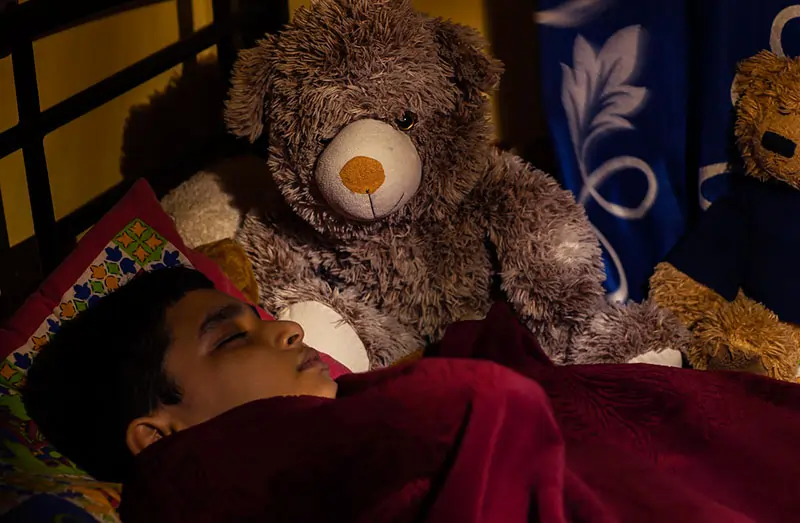The Importance of Bedtime Stories: Why Every Child Should Have a Nightly Storytime

The bedtime story ritual is a timeless tradition cherished by families around the world. Every night, parents or caregivers tuck their children into bed and open the pages of a book, weaving tales of adventure, mystery, and imagination. This simple yet profound act of reading to children before they drift off to sleep holds far more significance than many may realize. In this article, we explore the profound impact that this cherished tradition has on a child’s cognitive, emotional, and social development. From fostering a love for reading to nurturing creativity and empathy, bedtime stories are a powerful tool that can shape a child’s future. In the pages that follow, we will uncover the many layers of significance behind the nightly ritual of storytelling and why it should remain an integral part of every child’s upbringing.
The Tradition of Bedtime Stories
Bedtime stories are not a recent phenomenon; they have a rich history deeply intertwined with human culture. From ancient civilizations to modern societies, bedtime stories have played a significant role in nurturing generations of children. Here’s a glimpse into their historical and cultural significance:
1. Ancient Origins
- Bedtime stories can be traced back to ancient civilizations like Egypt and Mesopotamia, where oral traditions passed down stories from generation to generation.
- These stories often had moral lessons and were used to impart wisdom and values to children.
2. Folklore and Mythology
- In many cultures, bedtime stories involved retelling folklore, myths, and legends.
- These tales were not only entertaining but also served as a way to preserve cultural heritage and pass down important beliefs and customs.
3. Moral Education
- Bedtime stories were used as a tool for moral education, teaching children virtues such as honesty, kindness, and bravery.
- Aesop’s fables, for example, are a collection of ancient stories that impart valuable life lessons.
Evolution of Storytelling Over Time
The practice of bedtime storytelling has evolved alongside human society and technology. While the core purpose of these stories remains the same – to entertain, educate, and bond – the methods of delivery have changed dramatically.
1. Oral Tradition to Written Word
- In ancient times, stories were primarily passed down orally from one generation to another.
- The advent of writing and printing revolutionized storytelling, making it accessible to a wider audience.
2. Emergence of Fairy Tales
- The Brothers Grimm and Hans Christian Andersen popularized fairy tales in the 19th century, which became synonymous with bedtime stories.
- These tales often featured magical elements and memorable characters that captured children’s imaginations.
3. Modern Media and Digital Storytelling
- In the digital age, storytelling has expanded beyond books to include television, movies, and interactive apps.
- While these mediums offer new ways to engage with stories, they have not replaced the timeless tradition of bedtime storytelling.
Universality of Bedtime Stories Across Cultures
Bedtime stories are a universal human experience, transcending cultural boundaries and languages. Regardless of where one comes from, the tradition of telling stories before bedtime has common threads that connect people worldwide.
1. Shared Values
- Bedtime stories often emphasize universal values such as love, compassion, and courage.
- These shared themes create a sense of unity among diverse cultures.
2. Cultural Adaptations
- While stories themselves may vary, the concept of bedtime stories exists in nearly every culture.
- Stories are adapted to reflect the unique beliefs and traditions of each culture, preserving their heritage.
3. Family Bonding
- Across cultures, bedtime stories provide an opportunity for families to bond and create lasting memories.
- The act of storytelling fosters a sense of closeness and connection between parents and children, transcending cultural differences.
Imagination and Creativity
Bedtime stories, such as “Eclipse Arts by Michelle Chastaine,” play a significant role in nurturing a child’s creativity and imagination. When children listen to stories, their minds embark on a journey of endless possibilities.
- Expanding Horizons: Stories like those in “Eclipse Arts” introduce children to different worlds, cultures, and experiences. They transport young minds to far-off places and expose them to a wide array of characters and scenarios. This exposure encourages children to think beyond their immediate surroundings and consider the limitless possibilities the world has to offer.
- Character Identification: As children immerse themselves in stories, they relate to characters’ emotions, dilemmas, and growth. This emotional connection allows them to put themselves in the characters’ shoes, fostering empathy and a deeper understanding of human emotions and relationships.
The Importance of Visualizing Characters and Settings
Visualizing characters and settings is a crucial aspect of storytelling that fuels a child’s imagination.
- Creating Mental Images: When children hear about the appearance and personalities of characters or the description of a setting, they form mental images. These mental pictures are not only a reflection of what they hear but also a product of their own imagination. This active engagement enhances their cognitive skills.
- Stimulating Creativity: Encouraging children to visualize characters and settings encourages them to think creatively. They begin to picture new and exciting details, embellishing the story with their own imaginative additions.

Creative Thinking Can Benefit Other Aspects of Life
The creative thinking nurtured by bedtime stories goes beyond the realm of storytelling and has far-reaching effects in other areas of a child’s life.
- Problem Solving: Creative thinking allows children to approach problems from multiple angles and consider unconventional solutions. This problem-solving ability becomes a valuable life skill that can be applied in academics, personal relationships, and everyday challenges.
- Communication Skills: Children who engage with imaginative stories often develop better communication skills. They can express themselves more vividly and creatively, making them effective communicators in various contexts.
- Confidence and Innovation: The freedom to imagine and create fosters self-confidence. Children become more willing to explore their interests and pursue innovative ideas, which can lead to new hobbies, interests, or even career paths later in life.
Cognitive Development
Cognitive development in children is a multifaceted process that involves the growth of various mental abilities, including thinking, reasoning, memory, and problem-solving. Bedtime stories play a crucial role in nurturing these cognitive skills, offering more than just a cozy end to the day. Here, we will delve into how bedtime stories stimulate cognitive development in children, focusing on language acquisition and exposure to new words and concepts through storytelling.
Stimulating Brain Development
- Enhancing Brain Connectivity: When children listen to bedtime stories, their brains are actively engaged. As they visualize the story’s events and characters, their brains create new neural pathways. This process strengthens brain connectivity, promoting overall cognitive development.
- Strengthening Concentration: Following a narrative, even a simple one, demands sustained attention. This concentration can translate to better focus and improved cognitive abilities in other areas of a child’s life, including academics.
The Role of Storytelling in Language Acquisition
- Vocabulary Expansion: Bedtime stories introduce children to a wide range of words and phrases they might not encounter in everyday conversations. This exposure significantly contributes to expanding their vocabulary.
- Grammar and Syntax: Stories often follow grammatical rules and syntactical structures. Children subconsciously absorb these patterns, which can aid in their own language production and comprehension.
- Contextual Understanding: Through stories, children learn how words and phrases are used in different contexts. This contextual understanding is invaluable for effective communication.
Beneficial Exposure to New Words and Concepts
- Cultural and Scientific Knowledge: Bedtime stories can introduce children to cultural, historical, and scientific concepts they might not encounter otherwise. For example, a story about a different culture’s traditions can spark curiosity and broaden their horizons.
- Moral and Ethical Lessons: Many stories convey moral and ethical lessons, teaching children about right and wrong. These lessons foster critical thinking and ethical decision-making skills.
- Problem-Solving and Critical Thinking: Stories often present characters facing dilemmas or challenges. Children, through storytelling, learn to analyze these situations, consider possible solutions, and develop problem-solving skills.
- Creativity and Imagination: Exposure to fantastical and imaginative stories encourages children to think creatively and outside the box. They learn that there are limitless possibilities in the world of ideas and imagination.
Emotional and Social Development
Bedtime stories extend beyond the realm of cognitive development; they also play a vital role in nurturing a child’s emotional and social growth. In this section, we will explore how bedtime stories promote empathy and emotional intelligence, foster bonding and connection between parents and children, and facilitate the development of essential social skills through discussions about stories.
Promoting Empathy and Emotional Intelligence
- Character Identification: When children immerse themselves in stories featuring characters with diverse emotions and experiences, they learn to identify with these characters. This identification fosters empathy as they share in the characters’ joys, fears, and challenges.
- Understanding Complex Emotions: Bedtime stories often delve into complex emotional situations. As children encounter characters dealing with sadness, anger, or happiness, they gain a deeper understanding of these emotions and how to navigate them in their own lives.
- Moral Dilemmas: Many stories present moral dilemmas that require characters to make choices. Discussing these dilemmas with children encourages them to consider the consequences of actions and the impact of their decisions on others, thus developing emotional intelligence.
Bonding and Connection Between Parents and Children
- Quality Time: Bedtime stories provide a designated time for parents or caregivers to spend quality one-on-one time with their children. This shared experience strengthens the emotional bond between them.
- Comfort and Security: Storytelling can create a sense of comfort and security for children. The presence of a familiar and trusted adult during this time can have a soothing effect, promoting emotional well-being.
- Cultural Transmission: Through stories, parents can pass down cultural, familial, and personal values, traditions, and beliefs. This connection to one’s cultural and familial heritage is essential for a child’s sense of identity and belonging.
Development of Social Skills Through Discussions About Stories
- Communication Skills: Engaging in discussions about stories encourages children to express their thoughts and feelings. This practice improves their communication skills as they articulate their ideas and opinions.
- Active Listening: Listening to a story and participating in post-story discussions teach children the art of active listening, a fundamental skill for effective communication in social interactions.
- Respect for Diverse Perspectives: Stories often depict various characters with differing viewpoints and backgrounds. Discussing these differences helps children learn about diversity and develop respect for others’ perspectives.
- Conflict Resolution: Stories frequently feature conflicts and resolutions. Analyzing these aspects of a story helps children understand the dynamics of conflicts and strategies for peaceful resolution.
Bedtime Stories as a Relaxation Technique
Bedtime stories are not just a means of entertainment and learning; they also serve as an effective relaxation technique for children. In this section, we will delve into how bedtime stories can help children relax and unwind before sleep, the significance of routine and predictability in bedtime rituals, and the calming effects of a soothing bedtime story.
Helping Children Relax and Unwind Before Sleep
- Transition from Activity to Rest: Bedtime stories act as a transitional activity, signaling to children that it’s time to wind down and prepare for sleep. The act of sitting quietly and listening to a story helps shift their minds from the excitement of the day to a more relaxed state.
- Reduction of Anxiety: Stories provide a comforting and predictable routine that can reduce anxiety and fears that children may have about bedtime. Knowing what to expect can make the bedtime process more comforting.
The Role of Routine and Predictability in Bedtime Rituals
- Establishing Sleep Patterns: Consistent bedtime routines, such as reading a story, help establish healthy sleep patterns. The predictability of these routines signals to the body that it’s time to prepare for sleep, making it easier for children to fall asleep and stay asleep.
- Sense of Security: Routine provides a sense of security and comfort for children. They know what to expect at bedtime, which can reduce resistance to going to bed and make the experience more enjoyable.
- Parent-Child Bonding: Following a familiar routine, such as bedtime stories, creates a bonding experience between parents or caregivers and children. It’s a special time for connection, reinforcing the emotional security necessary for restful sleep.
Calming Effects of a Soothing Bedtime Story
- Lowering Stress Levels: Listening to a soothing bedtime story can lower cortisol levels, reducing stress and anxiety. This is particularly beneficial for children who may have had a busy or stressful day.
- Improved Sleep Quality: The calming effects of a bedtime story can lead to improved sleep quality. Children who are relaxed are more likely to have deeper and more restorative sleep.
- Positive Associations with Bedtime: When bedtime is associated with positive experiences like storytelling, children are more likely to view sleep in a positive light and be less resistant to bedtime.
Conclusion
The tradition of bedtime stories is not merely a routine; it is a cornerstone of childhood development with profound and lasting effects. From its ancient origins to its contemporary adaptations, bedtime stories have transcended time and culture, binding generations with the magic of storytelling. This article has explored the multi-dimensional impact of bedtime stories on children, shedding light on the cognitive, emotional, and social dimensions of their growth.



Pretty! This has been an extremely wonderful article.
Thank you for supplying these details.